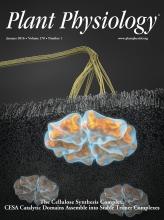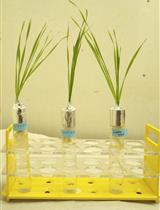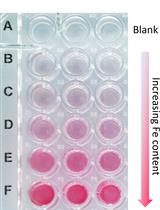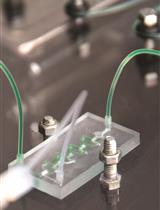- EN - English
- CN - 中文
Assessing Long-distance Transport from Photosynthetic Source Leaves to Heterotrophic Sink Organs with [14C]CO2
利用[14C]CO2评估从光合源叶到异养库器官的远距离运输
发布: 2017年12月20日第7卷第24期 DOI: 10.21769/BioProtoc.2657 浏览次数: 5981
评审: Anonymous reviewer(s)
Abstract
Phloem loading and transport of photoassimilate from photoautotrophic source leaves to heterotrophic sink organs are essential physiological processes that help the disparate organs of a plant function as a single, unified organism. We present three protocols we routinely use in combination with each other to assess (1) the relative rates of sucrose (Suc) loading into the phloem vascular system of mature leaves (Yadav et al., 2017a), (2) the relative rates of carbon loading and transport through the phloem (Yadav et al., 2017b), and (3) the relative rates of carbon unloading into heterotrophic sink organs, specifically roots, after long-distance transport (this protocol). We propose that conducting all three protocols on experimental and control plants provides a reliable comparison of whole-plant carbon partitioning, and minimizes ambiguities associated with a single protocol conducted in isolation (Dasgupta et al., 2014; Khadilkar et al., 2016). In this protocol, [14C]CO2 is photoassimilated in source leaves and phloem loading and transport of the 14C label to heterotrophic sink organs, particularly roots, is quantified by scintillation counting. Using this protocol, we demonstrated that overexpression of sucrose transporters and a vacuolar proton pumping pyrophosphatase in the companion cells of Arabidopsis enhanced transport of 14C label photoassimilates to sink organs (Dasgupta et al., 2014; Khadilkar et al., 2016). This method can be adapted to quantify long-distance transport in other plant species.
Keywords: Arabidopsis (拟南芥)Background
Long-distance transport through the phloem from autotrophic source organs to heterotrophic sinks is fundamental to plant growth and yield. Based on its role and its location in the plant and its prevailing function in that location, the phloem network is commonly divided into the collection phloem, the transport phloem, and the release phloem (Ayre, 2011). The collection phloem is where sugars and other compounds are loaded into the phloem in preparation for transport. In established plants, the collection phloem is the minor veins of mature, photoautotrophic leaves where phloem loading occurs. Our first companion protocol (Yadav et al., 2017a) describes how [14C]Suc is used to quantify phloem loading capacity in leaf disks. The transport phloem connects source and sink tissues and represents the longest contiguous stretch of phloem in the long-distance-transport pathway. All photoassimilate destined for the heterotrophic sinks moves along the transport phloem, but the transport phloem is far from a simple pipe connecting regions where most of the loading and unloading occurs. Lateral tissues require nutrients and also act as transient storage reserves in stems and roots such that exchange between the transport phloem and adjacent tissue is highly dynamic (discussed at length in Ayre, 2011). Our second companion protocol (Yadav et al., 2017b) describes how 14C labeling with [14C]CO2 can be coupled with collecting phloem exudates into EDTA solutions to measure photoassimilate loaded into the collection phloem and moving through the transport phloem. The release phloem generally refers to that in terminal sink tissues at or very near the end of the phloem network where rates of unloading are highest. The release phloem is found in regions of rapid cell division and growth, or in storage organs, where resources are most strongly needed. The unloading mechanism from the phloem tissue itself is commonly through plasmodesmata into symplastic domains within the recipient tissue. Subsequent transport across membranes to the apoplast, followed by uptake into adjacent cells, occurs in some organs. Symplastic domains and apoplastic boundaries have been elegantly demonstrated with the green fluorescent protein, which moves readily through apical tips and ovule integuments when unloaded from the release phloem, but does not enter the filial tissue of seeds, which is symplastically isolated from maternal tissues (Stadler et al., 2005a; Stadler et al., 2005b). Here we describe a protocol for photosynthetically labeling source leaves with [14C]CO2 and measuring transport to heterotrophic sink organs, specifically roots. An advantage of this protocol is that it takes a whole-plant, holistic approach to quantifying source to sink relationships between control and experimental plants. A disadvantage is that it does not provide information on the individual steps of the transport process.
Materials and Reagents
- Microcentrifuge tubes, screw cap with O-rings (Thermo Fisher Scientific, Thermo ScientificTM, catalog number: 3464 )
- Pasteur pipette
- [14C]CO2 labeling chambers derived from square Petri dishes (100 x 100 x 15 mm, Fisher Scientific, catalog number: FB0875711 A; or larger 120 x 120 mm, Fisher Scientific, catalog number: 07-000-330 )
- Sterile scalpel
- Circular deep-well Petri dishes for germinating seeds (100 x 25 mm) (Fisher Scientific, catalog number: FB0875711 )
- Surgical white porous tape (3M, catalog number: 1530-0 )
- 10 ml syringe (without a needle attached) (Luer-Lok Tip) (BD, catalog number: 309604 )
- 1 ml plastic syringe barrel (Luer-Lok Tip) (BD, catalog number: 309628 ), cut to 3 cm, and plunger
- Syringe needle, 1.5-2.0 inches, 18 gauge (Monoject Needle, Covidien, catalog number: 1188818112 )
- Scintillation vials (Fisher Scientific, catalog number: 03-337-15 )
- Double edge razor blades (PERSONNA brand, Electron Microscopy Sciences, catalog number: 72000 )
- Modeling clay (American Art Clay)
- Control and experimental plant material
- Sodium bicarbonate [14C]NaHCO3 (MP Biomedicals, catalog number: 0117441H ; 40-60 mCi/mmol; 2 mCi/ml; 5 mCi; 185 MBq)
- Sodium hypochlorite (NaClO) (Commercial bleach)
- Dow Corning high vacuum grease
- Lactic acid (85%) (Fisher Scientific, catalog number: A162-500 )
- Soda lime (LI-COR, catalog number: 9964-090 ) in a column (e.g., Bio-Rad Econo-Column, 1.5 x 20 cm, Bio-Rad Laboratories, catalog number: 7371522 )
- Ethanol absolute (Pharmco-AAPER, catalog number: 111000200 )
- Murashige and Skoog (MS) medium with Gamborg vitamins (PhytoTechnology Laboratories, catalog number: M404 ) or other synthetic, sterile medium suitable for plant growth in vertically-oriented Petri plates (see Recipes for seed germination and experiments)
- Sucrose (Sigma-Aldrich, catalog number: S0389 )
- Potassium hydroxide (Fisher Scientific, catalog number: P250-500 )
- Gellan gum (PhytoTechnology Laboratories, catalog number: G434 )
- Ecolume scintillation fluid (MP Biomedicals, catalog number: 0188247004 )
- Half-strength Murashige and Skoog (MS) medium with Suc for seed germination (see Recipes)
- Half-strength Murashige and Skoog (MS) medium without Suc for experiments (see Recipes)
Equipment
- Glassware, balance, stir plates, pH meter, autoclave, water bath, clean bench, etc., for sterile media
- Desiccator (2.5 L) for sterilizing seeds (Kimble, catalog number: 31200-150 )
- Environmental growth chambers for growing control and experimental plants
- Personal safety equipment: lab coat, nitrile gloves (or similar), and eye protection
- Lamp suitable for photosynthetic labeling, such as a 400 W metal halide lamp (SYLVANIA 64490 - 400 Watt - BT37 - Metal Halide)
- Fume hood with appropriate support for metal halide lamp (see Figure 1, Yadav et al., 2017b,)
- Slim line micro blowers for air circulation (optional; Exton PA, Pelonis Technologies, catalog number: RFB3004 ; powered by four 1.5 volt D-cell batteries in sequence to provide 6 volts)
- Small vacuum pump with inlet and outlet (e.g., Airpo, Barcodable, catalog number: UPC 045635496699 )
- Geiger counter (Ludlum Measurements, model: Model 3 )
- Scissors (Fisher Scientific, catalog number: 08-951-20 )
- Scalpel handle (Fine Science Tools, catalog number: 10003-12 )
- Scalpel blades (Fine Science Tools, catalog number: 10011-00 )
- Forceps, fine, such as Dumont fine point No. 5 (Fine Science Tools, catalog number: 11251-10 )
- Balance (METTLER TOLEDO, model: AE100 )
- Microcentrifuge (GeneMate, catalog number: C-1301-PC )
- Rotary platform shaker (Orbital Shaker Variable, BioExpress, GeneMate, catalog number: S-3200-LS )
- Scintillation counter (Beckman Counter, model: LS 6000IC )
- Water bath
Procedure
文章信息
版权信息
© 2017 The Authors; exclusive licensee Bio-protocol LLC.
如何引用
Readers should cite both the Bio-protocol article and the original research article where this protocol was used:
- Yadav, U. P., Khadilkar, A. S., Shaikh, M. A., Turgeon, R. and Ayre, B. G. (2017). Assessing Long-distance Transport from Photosynthetic Source Leaves to Heterotrophic Sink Organs with [14C]CO2. Bio-protocol 7(24): e2657. DOI: 10.21769/BioProtoc.2657.
- Khadilkar, A. S., Yadav, U. P., Salazar, C., Shulaev, V., Paez-Valencia, J., Pizzio, G. A., Gaxiola, R. A. and Ayre, B. G. (2016). Constitutive and companion cell-specific overexpression of AVP1, encoding a proton-pumping pyrophosphatase, enhances biomass accumulation, phloem loading, and long-distance transport. Plant Physiol 170(1): 401-414.
分类
植物科学 > 植物生理学 > 营养
植物科学 > 植物生理学 > 光合作用
您对这篇实验方法有问题吗?
在此处发布您的问题,我们将邀请本文作者来回答。同时,我们会将您的问题发布到Bio-protocol Exchange,以便寻求社区成员的帮助。
提问指南
+ 问题描述
写下详细的问题描述,包括所有有助于他人回答您问题的信息(例如实验过程、条件和相关图像等)。
Share
Bluesky
X
Copy link












